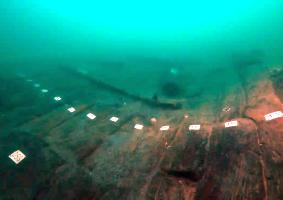
Photo: Christoph Gerigk/Franck Goddio/Hilti Foundation
Six years ago, we posted about the sunken lost city of Thonis-Heracleion in Abu Qir Bay near the Canopic Mouth of the Nile. The city sank into the Mediterranean around 1,2000 years ago and was only rediscovered in 1999. The city dates back roughly 2,700 years and was a major trading port for centuries.
Now marine archeologists have excavated a baris, a type of ship described by the Greek historian Herodotus in the 5th century BCE, from Thonis-Heracleion. The construction of the craft is unique. Here is what Herodotus wrote about the baris:
From [the acacia] tree they cut pieces of wood about two cubits in length and arrange them like bricks, fastening the boat together by running a great number of long bolts through the two-cubit pieces; and when they have thus fastened the boat together, they lay cross-pieces[81] over the top, using no ribs for the sides; and within they caulk the seams with papyrus.
The Guardian reports: For centuries, scholars have argued over his account because there was no archaeological evidence that such ships ever existed. Now there is. A “fabulously preserved” wreck in the waters around the sunken port city of Thonis-Heracleion has revealed just how accurate the historian was.
“It wasn’t until we discovered this wreck that we realized Herodotus was right,” said Dr. Damian Robinson, director of Oxford University’s Center for Maritime Archaeology, which is publishing the excavation’s findings. “What Herodotus described was what we were looking at.”
But the excavation of what has been called Ship 17 has revealed a vast crescent-shaped hull and a previously undocumented type of construction involving thick planks assembled with tenons – just as Herodotus observed, in describing a slightly smaller vessel.
Originally measuring up to 28 meters long, it is one of the first large-scale ancient Egyptian trading boats ever to have been discovered.
Robinson added: “Herodotus describes the boats as having long internal ribs. Nobody really knew what that meant… That structure’s never been seen archaeologically before. Then we discovered this form of construction on this particular boat and it absolutely is what Herodotus has been saying.”
About 70% of the hull has survived, well-preserved in the Nile silts. Acacia planks were held together with long tenon-ribs – some almost 2m long – and fastened with pegs, creating lines of ‘internal ribs’ within the hull. It was steered using an axial rudder with two circular openings for the steering oar and a step for a mast towards the center of the vessel.
Robinson said: “Where planks are joined together to form the hull, they are usually joined by mortice and tenon joints which fasten one plank to the next. Here we have a completely unique form of construction, which is not seen anywhere else.”
Alexander Belov, whose book on the wreck, Ship 17: a Baris from Thonis-Heracleion, is published this month, suggests that the wreck’s nautical architecture is so close to Herodotus’s description, it could have been made in the very shipyard that he visited. Word-by-word analysis of his text demonstrates that almost every detail corresponds “exactly to the evidence”.

Fascinating. And thanks to the link to your article six years ago. Will you be reviewing Belov’s book?
It’s obvious “Fake News” is a much more recent creation!